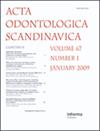Chewing Side Preference, Facial Asymmetry and Related Factors in the Northern Finland Birth Cohort 1986.
IF 1.9
4区 医学
Q3 DENTISTRY, ORAL SURGERY & MEDICINE
引用次数: 0
Abstract
OBJECTIVE The aim of this study was to find out how the preferred chewing side (PCS) affects facial asymmetry, what kind of factors affect PCS, and whether there are differences in facial asymmetry between symmetrical and asymmetrical masticators. MATERIAL AND METHODS The study included 748 subjects (females n=452, males n=296) born in 1985-1986 in Northern Finland (Northern Finland Birth Cohort 1986, NFBC 1986). Subjects' faces were captured in facial 3D images with stereophotogrammetry technology, and they filled in a questionnaire concerning oral health. A comprehensive dental examination was done by a dentist. Subject´s chewing side preference was studied by chewing a piece of paraffin, cotton roll or parafilm. Asymmetry was measured from 3D images with different asymmetry measurements and facial landmarks. RESULTS Reduced number of teeth on contralateral side affects PCS (OR = 2.44 in the case of one tooth is missing). Being female increased the whole face and lower face symmetry (p values <0.001-0.824). Self-reported TMD pain has an effect on the sidedness of the chin; there is more pain in the larger side of the chin (OR = 9.45). Different chewing materials had no significant effect on the proportion of chewing sides. CONCLUSIONS Females have a more symmetrical face compared to males. PCS does not have a statistically significant effect on facial asymmetry, but the variable affecting PCS itself is extracted teeth.1986 年北芬兰出生队列中的咀嚼侧偏好、面部不对称及相关因素。
材料和方法本研究纳入了 748 名 1985-1986 年出生在芬兰北部的受试者(女性 n=452,男性 n=296)(1986 年芬兰北部出生队列,NFBC 1986)。受试者的面部通过立体摄影测量技术拍摄成面部三维图像,并填写了一份有关口腔健康的问卷。牙医对受试者进行了全面的牙科检查。通过咀嚼石蜡、棉花卷或塑料薄膜,研究了受试者的咀嚼偏好。结果对侧牙齿数量减少会影响 PCS(缺失一颗牙齿的 OR = 2.44)。女性会增加整个脸部和下脸部的对称性(P 值<0.001-0.824)。自我报告的 TMD 疼痛对下巴的偏侧有影响;下巴较大的一侧疼痛较重(OR = 9.45)。不同的咀嚼材料对咀嚼侧的比例没有明显影响。PCS 对面部不对称没有显著的统计学影响,但影响 PCS 本身的变量是拔牙。
本文章由计算机程序翻译,如有差异,请以英文原文为准。
求助全文
约1分钟内获得全文
求助全文
来源期刊

Acta Odontologica Scandinavica
医学-牙科与口腔外科
CiteScore
4.00
自引率
5.00%
发文量
69
审稿时长
6-12 weeks
期刊介绍:
Acta Odontologica Scandinavica publishes papers conveying new knowledge within all areas of oral health and disease sciences.
 求助内容:
求助内容: 应助结果提醒方式:
应助结果提醒方式:


